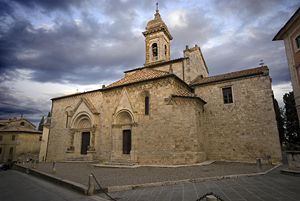Isabelle à St Quirico d'Orcia le 27/11/2008.
Collégiale Panneau central du polyptyque de Sano diPietro
Une petite révision d'anglais, désolé je n'ai rien trouvé en français mais si vous voulez j'ai aussi de l'italien!!!
History of San Quirico d'Orcia:
San Quirico d'Orcia is Etruscan in origin, and cinerary urns and other funeral objects and vessels found here are now kept in the Etruscan archeological museum in Sienna. The first explicit reference to San Quirico was at the time of a dispute, in 712, between the diocese of Sienna and Arezzo over the possession of some parishes, among which was San Quirico in Osenna. The outcome of this dispute was a decision, confirmed by King Liutprando, in favour of the church of Arezzo. The name "Osenna" was in use until the 17 C and probably referred to a water-course which has now disappeared. It is an Etruscan place-name and perhaps even "Orcia" (water, stream or brook) is pre-Roman. From the beginning of the 11 C, the name of San Quirico in Osenna is mentioned more frequently, especially in connection to travel along the important Via Francigena (or Romea, the pilgrims' way to Rome) by important Europeans in the political and ecclesiastical world. In 1154, Federico I (Barbarossa) came to Italy to receive the Imperial Crown. While heading towards Rome, his army encamped at San Quirico, where Pope Adrian IV sent three cardinals to meet the him. In 1180, the Siennese extended their jurisdiction over San Quirico and soon after that the town became the seat of the Imperial Vicar. At San Quirico, in 1205, a congress of the "Lega di Toscana" (League of Tuscany) was held. With the fall of the Republic of Sienna, San Quirico passed into the hands of the Marchese of Marignano and, some time after, it was under the rule of Cosimo de' Medici. After becoming the cause of a feud for the title of marquisate by Grand Duke Cosimo III, in 1677 it was conceded to Cardinal Flavio Chigi, nephew of Pope Adrian VII.


/https%3A%2F%2Fstorage.canalblog.com%2F82%2F48%2F422276%2F79213644_o.jpg)
/https%3A%2F%2Fstorage.canalblog.com%2F37%2F53%2F422276%2F79212001_o.jpg)
/https%3A%2F%2Fstorage.canalblog.com%2F20%2F78%2F422276%2F78996027_o.jpg)
/https%3A%2F%2Fstorage.canalblog.com%2F51%2F90%2F422276%2F78962281_o.jpg)
/https%3A%2F%2Fstorage.canalblog.com%2F54%2F35%2F422276%2F78747224_o.jpg)




/https%3A%2F%2Fassets.over-blog.com%2Ft%2Fcedistic%2Fcamera.png)
/http%3A%2F%2Fstorage.canalblog.com%2F83%2F24%2F422276%2F43456331_o.jpg)
/http%3A%2F%2Fstorage.canalblog.com%2F96%2F75%2F422276%2F43454712_o.jpg)
/https%3A%2F%2Fprofilepics.canalblog.com%2Fprofilepics%2F3%2F6%2F362844.jpg)